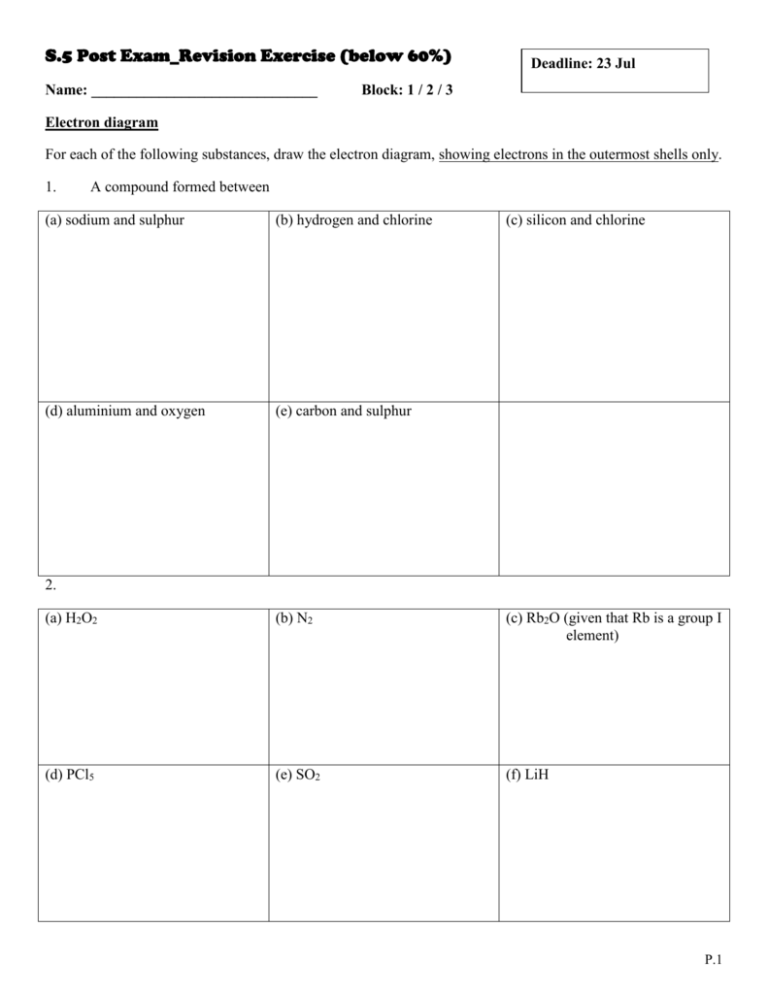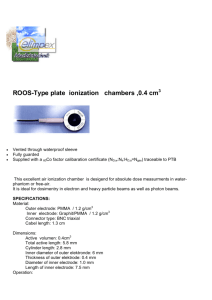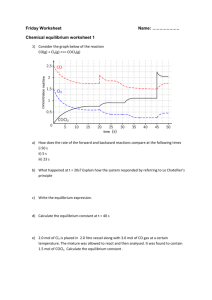Document
advertisement

S.5 Post Exam_Revision Exercise (below 60%) Name: ______________________________ Deadline: 23 Jul Block: 1 / 2 / 3 Electron diagram For each of the following substances, draw the electron diagram, showing electrons in the outermost shells only. 1. A compound formed between (a) sodium and sulphur (b) hydrogen and chlorine (d) aluminium and oxygen (e) carbon and sulphur (c) silicon and chlorine 2. (a) H2O2 (b) N2 (c) Rb2O (given that Rb is a group I element) (d) PCl5 (e) SO2 (f) LiH P.1 Acids, Bases and Volumetric analysis 1. Suggest how you would carry out chemical test(s) to distinguish the two substances from one another. (a) concentrated hydrochloric acid and concentrated nitric acid (b) sodium carbonate and potassium nitrate (c) zinc sulphate and magnesium sulphate 2. Ammonia can be used to manufacture nitrogen-containing fertilizer. A chemist carried out an experiment to determine the percentage by mass of nitrogen in a sample of nitrogen-containing fertilizer, which contained ammonium ions as the only source of nitrogen. The experiment consisted of three stages: Stage 1 4.65 g of the sample were dissolved in distilled water and then made up to 250.0 cm3. Stage 2 25.0 cm3 of this solution were heated with 25.0 cm3 of 0.250 mol dm–3 sodium hydroxide solution until no more ammonia gas was evolved. Stage 3 The resulting solution was titrated against 0.200 mol dm–3 hydrochloric acid. 16.2 cm3 of the acid were required to reach the end point. (a) Briefly describe how the 250.0 cm3 solution was made up in Stage 1. State the apparatus used clearly in your answer. P.2 (b) Write an ionic equation for the reaction that occurred in Stage 2. (c) Suggest a suitable indicator for the titration in Stage 3, and state the expected colour change at the end point. (d) (i) Based on the titration result in Stage 3, calculate the number of moles of sodium hydroxide left over in 25.0 cm3 of the resulting solution. (ii) Calculate the number of moles of sodium hydroxide reacted with the ammonium ions in 25.0 cm3 of the solution in Stage 2. (iii) Calculate the percentage by mass of nitrogen in the fertilizer. P.3 Redox reactions 1. Calculate the oxidation number of the underlined elements in the following species. (a) H2S (b) Na2SO3 (c) CuSO4 (d) S2O32(f) S8 (g) Ag (h) AgCl (i) MnO2 (k) N2 (l) NO2 (m) HNO3 (n) NH3 (p) IO3 (q) ICl (r) Cl2O (s) Zn(OH)2 23+ (u) HPO4 (v) PCl3 (w) Cr (x) CrO42- (e) S2O82(j) MnO4(o) KI *(t) H2O2 (y) Fe2O3 2. Explain whether the following reactions are redox reactions. For each redox reaction, state the oxidizing agent (O.A.) and reducing agent (R.A.). Equation Redox (Yes or No) O.A. R.A. (a) H2SO4(aq) + Na2CO3(aq) Na2SO4(aq) + CO2(g) + H2O(l) (b) H2(g) + 2MnO2(s) H2O(l) + Mn2O3(s) (c) 3Mg(s) + N2(g) Mg3N2(s) (d) Fe(NO3)2(aq) + 2NaOH(aq) Fe(OH)2(s) + 2NaNO3(aq) (e) NH4Cl(aq) + NaOH(aq) NaCl(aq) + NH3(aq) + H2O(l) 3. Write an equation for each of the following redox reactions. (a) Zinc with silver nitrate solution (b) Potassium iodide solution with chlorine solution (c) Sodium sulphite solution with acidified potassium permanganate solution (d) Iron (II) sulphate solution with acidified potassium dichromate solution. (e) Sulphur dioxide with bromine solution P.4 (f) Very dilute nitric acid with magnesium (g) Dilute nitric acid with magnesium (h) Concentrated nitric acid with zinc (i) Concentrated sulphuric acid with copper Electrochemistry 1. In the following diagram, P and Q are two different metals. When the circuit is closed, an electric current flows in the external circuit. After some time, some reddish brown solids are deposited on the carbon electrode R. (i) What is the direction of electron flow in the external circuit? Explain your answer. (ii) After the circuit has been closed for some time, what would be observed (1) at the carbon electrode S? (2) in the copper(II) sulphate solution? (iii) Write the half-equation for the expected change at each of the following electrodes: (1) electrode made of metal P (Given that P is a group II element.) P.5 (2) electrode made of metal Q (Given that Q is a group II element.) (ii) What is the function of set-up X in this experiment? 2. The following circuit is set up to study the effect of electrolysis on copper (II) sulphate solution and concentrated sodium chloride solution. Electrodes A, B, C and D are all carbon electrodes. electrode C electrode D electrode A copper (II) sulphate solution electrode B concentrated sodium chloride solution (a) Write a half equation for the reaction at electrode A. (b) Write half equations for the reactions at electrodes C and D respectively. (c) Identify with explanation which electrode, C or D, is the anode. (d) What would be observed in the copper (II) sulphate solution if current is passed through the circuit for some time? (e) After passing current through the circuit for 20 minutes, the polarity of the battery is reversed. What would be observed at electrode D afterwards? P.6 Polymers and Intermolecular forces 1. Polyethylene terephthalate (PET) is a thermoplastic that can be used to make soft drink bottles. PET is formed from polymerization of two different monomers and has the following structure: (a) Write the structural formulae of two monomers that can be polymerized to form PET. (b) Name the type of the above polymerization and give the reason. (c) In terms of intermolecular forces, explain why PET can be softened on gentle heating. (d) PET bottles CANNOT be used to store the drainage cleaners containing concentrated sodium hydroxide solution because PET reacts with the strong alkalis. (i) What is the reaction involved? (ii) Write the structural formula of one of the products of the reaction. (e) Polypropene (PP) can be used to make bottles for storing drain cleaners containing strong alkalis. Write a chemical equation to show the formation of PP. P.7 2. (a) Polyethene (PE) is a commonly used plastic in making shopping bags. Write the chemical equation for the formation of PE from its monomer. (b) Some scientists suggested using polylactic acid (PLA) instead of PE to make the shopping bags as this can help reduce the environmental problems. PLA is a polyester made form lactic acid, which has the following structure. (i) Identify the functional groups in lactic acid. (ii) Write the repeating unit of PLA. (iii)Explain, in chemical terms, why the disposal of PLA poses less harm to the environment than that of PE. Chemistry of Carbon Compounds and Isomerism Suggest a synthetic route (not more than four steps) with the corresponding intermediates, reagents and conditions for each of the following conversions. 1. (a) P.8 (b) (c) (d) P.9 2. Organic compounds X, Y and Z have the same molecular formula of C3H6O2. Compound X reacts with sodium carbonate solution to give a colourless gas. Compound Y has a characteristic sweet fruity smell. Compound Z has a chiral carbon atom. (a) (b) (c) (i) Give the structure of compound X. (ii) Write a balanced chemical equation for the reaction between compound X and sodium carbonate solution. (i) Give the structure of compound Y. (ii) Compound Y undergoes alkaline hydrolysis to give two products. Give the structures of the products. (i) Give the structure of compound Z and mark the chiral carbon atom with an asterisk(*). (ii) Compound Z is heated under reflux with acidified potassium dichromate solution to given a product. Give the structure of the product. P.10 3. Describe the relationship between each pair of structures shown below by writing the appropriate letter representating the following terms: (a) identical (b) enantiomers (c) structural isomers (d) cis-trans isomers. (a) (b) O O C C H (c) OCH2CH3 HO CH2CH3 (d) (e) (f) (g) (h) P.11 Energetics 1. (a) A student carried out an experiment to determine the enthalpy change of the reaction of calcium oxide with water. The set-up used is shown on the right. The experimental results are as follows: mass of CaO(s) used volume of water in the cup initial temperature of water in the cup = 3.0 g = 50.0 cm3 = 28.2°C highest temperature attained by the Ca(OH)2(aq) formed = 46.7°C (i) Calculate the enthalpy change, in kJ mol–1, of the reaction of calcium oxide with water under the conditions of the experiment. (Assume: density of water is 1.0 g cm–3 and specific heat capacity of the Ca(OH)2(aq) formed is 4.2 J g–1K–1; the polypropene cup, thermometer and stirrer used all have negligible heat capacity. ) (ii) According to the literature, ∆HØ for this reaction is –82.2 kJ mol–1. Other than ‘heat loss to the surroundings’, suggest ONE reasonable explanation for the discrepancy between the literature value and the value obtained in (i). (b) The diagram below shows the design of a can of self-heating coffee beverage. When the bottom of the can is pushed, the rod will pierce the aluminium foil and cause mixing of the water and calcium oxide. The coffee beverage in the can will then be heated up. (i) With reference to the properties of the materials involved, explain why (I) a polypropene container is used; and P.12 (b) (i) (II) an aluminium container is used to contain the coffee beverage. (ii) Suggest ONE reasonable explanation for using calcium oxide in this type of self-heating beverage can. Reaction rate An experiment was performed using the displacement of water to follow the progress of the reaction between 0.35 g of zinc power and excess dilute hydrochloric acid. The volume of the gaseous product formed at regular time interval was measured. The graph below shows the results. (a) Calculate the volume of the gaseous product produced, at room temperature and pressure, from the reaction. (Relative atomic mass: Zn = 65.4; molar volume of gases at room temperature and pressure = 24 dm 3) (b) (i) How does the reaction rate change as the reaction proceeds? P.13 (b) (ii) Explain the change in the reaction rate in terms of collision theory. (c) The experiment is repeated with the following changes respectively. (I) Doubling the volume of the dilute hydrochloric acid. (II) Using equal mass of the zinc strips. Sketch the curves on the graph given above to show the effect of each of the changes. Label the curves as ‘(I)’ and ‘(II)’ respectively. (d) Suggest an alternative method to monitor the progress of this reaction. Equilibrium 1. A mixture of 5.0 mol C(s), 5.0 mol H2O(g), 0.4 mol H2(g) and 0.4 mol CO(g) is placed into a 2.0 dm3 vessel and heated to 730 oC. The equation of the reaction is shown below: C(s) + H2O(g) H2(g) + CO(g) The equilibrium constant, Kc, for the reaction at 730 oC is 0.05 mol dm-3. (a) Calculate the reaction quotient, Qc, of the mixture and predict the direction of the shift of equilibrium position. P.14 (b) Calculate the equilibrium concentration of H2(g) when the equilibrium is attained at 730 oC. (c) Explain the effect on the equilibrium position of the reaction if the volume of the vessel is increased while the temperature of the system is kept at 730 oC. 2. The following dynamic equilibrium was established at temperature T in a closed container. + 50 kJ mol-1 The value of Kc for the reaction was 68.0 mol-1 dm3 when the equilibrium mixture contained 3.82 mol of P and 5.24 mol of R. (a) Give the meaning of the term dynamic equilibrium. P.15 (b) Write an expression for Kc for this reaction. (c) The volume of the container was 10.0 dm3. Calculate the concentration, in mol dm-3, of Q in the equilibrium mixture. (d) State the effect, if any, on the equilibrium amount of P of (i) increasing the temperature, while keeping other factors unchanged. (ii) using a container of larger volume, while keeping other factors unchanged. (e) State the effect, if any, on the value of Kc of (i) increasing the temperature, while keeping other factors unchanged. (ii) using a container of larger volume, while keeping other factors unchanged. (f) Deduce the value of the equilibrium constant, at temperature T, for the reaction -EndP.16









